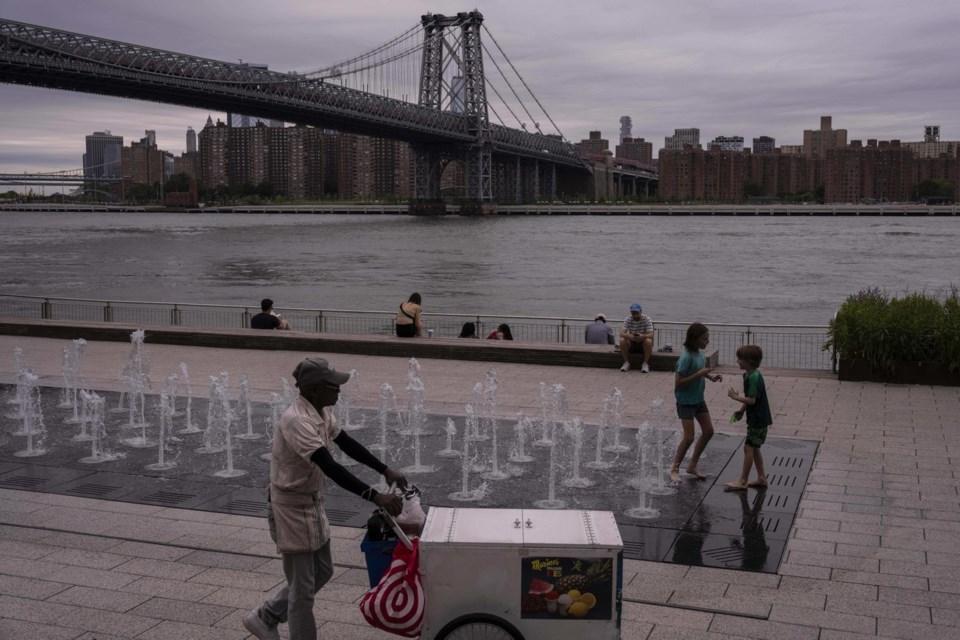After days of blistering heat, the got to open windows, step outside and get temporary relief on Friday as temperatures plummeted as much as 40 degrees and humidity dropped alongside.
At least 68 record highs were set and more than 20 places logged triple-digit heat from Sunday through Wednesday before a cold front from the north broke on the region Friday. Boston, which hit a record 102 Fahrenheit (about 39 Celsius) on Tuesday, was at 61 (about 16 Celsius) on Friday.
That blast of cool comfort brought temperatures as much as 10 to 15 degrees below normal but didn't come close to breaking cold records, said Frank Pereira, a meteorologist at the National Weather Service's Weather Prediction Center.
About the only place that could break a cool record of any kind Friday is one tiny station in Philadelphia, at the Franklin Institute, where the lowest recorded high for the day is 75 (about 24 Celsius). It was expected to get up to only about 72 (about 22 Celsius), Pereira said. But records don't go back very far at that site and meteorologists in Philadelphia don't consider it representative of the area, which is unlikely to get a record for cool, said meteorologist Ray Martin in the local weather forecast office in Mount Holly, New Jersey.
That's what's so telling about this weather whiplash from hot to cool — and soon to go back to hot — said Climate Central chief meteorologist Bernadette Woods Placky.
“We've had so many record highs, not only our daytime maximum temperatures, but our overnight low temperatures throughout a widespread region of the country, so this massive shift feels great and it's giving everyone a break, which is nice,” Woods Placky said. “But it's not necessarily coming with record lows on the other side.”
That's a signature of from the burning of fossil fuels, she said: “We're getting so many record highs any more that it doesn't feel like it's big news because it's happening so often. But we just don't get as many record lows as frequently.”
Climate Central's record tracker shows 68 high temperature marks set since Sunday and only three low ones: Billings, Montana; Casper, Wyoming; and Jackson, Idaho — all recorded on Sunday.
For the first five months of this year, there have been nearly twice as many daily high records — 14,863 — set in the United States as low records — 7,855 — according to records compiled by meteorologist Guy Walton, who tracks NWS records. For the 2020s as a whole it's well over double with 221,971 daily high records set and 93,429 daily low records set.
Except for the Dust Bowl era — which the ratio of highs to lows still don't come close to doubling — the number of record daily highs and lows were within 20% of each other from the 1920s to the 1980s, but since then the ratio of record heat to record cold has taken off.
This Eastern cooling won't last, the weather service's Pereira said. Soon the heat will be back and temperatures in the East will once again be above normal, even for summer.
But, he said, “We're not looking at temperatures that are as oppressive as they were earlier in the week.”
Weather whiplash from one extreme to another is often a sign of human-caused climate change because the jet stream — the river of air high above us that moves weather systems along generally from west to east — is weakening, getting wavier and getting stuck more because of global warming, Woods Placky and other scientists said.
When that happens, it means more extremes such as a heat wave or a drought or downpours. And then when the stuck jet stream moves on, it sometimes results in opposite extreme weather.
___
Isabella O'Malley contributed from Philadelphia.
___
The Associated Press’ climate and environmental coverage receives financial support from multiple private foundations. AP is solely responsible for all content. Find AP’s for working with philanthropies, a list of supporters and funded coverage areas at .
Seth Borenstein, The Associated Press



